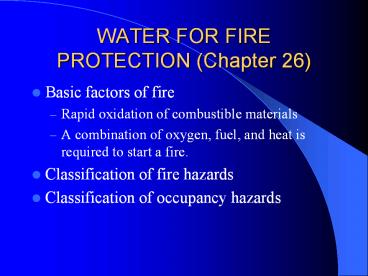WATER FOR FIRE PROTECTION (Chapter 26) - PowerPoint PPT Presentation
Title:
WATER FOR FIRE PROTECTION (Chapter 26)
Description:
... WATER FOR FIRE PROTECTION DESIGN OF SPRINKLER SYSTEMS (Additional information) Sprinkler head sizes (Additional information) WATER FOR FIRE PROTECTION ... – PowerPoint PPT presentation
Number of Views:50
Avg rating:3.0/5.0
Title: WATER FOR FIRE PROTECTION (Chapter 26)
1
WATER FOR FIRE PROTECTION (Chapter 26)
- Basic factors of fire
- Rapid oxidation of combustible materials
- A combination of oxygen, fuel, and heat is
required to start a fire. - Classification of fire hazards
- Classification of occupancy hazards
2
WATER FOR FIRE PROTECTION (Additional information)
- Objectives in fire safety
- Protection of life
- Evacuation of people the time interval between
detection of fire and arrival of fire fighters. - Providing adequate number of fire exits and
clearly defined access (i.e. corridors, hallways,
etc.) to exits. - Absolute minimum width of an exit access is 28".
- In order to accommodate adults using various
walking aids, corridors should be at least 36"
wide. - The standard unit of exit width computation is
22" (i.e. 22" 1 exit unit). - Exit Width Units Floor area of the building in
sq. ft./(occupant density in sq. ft./person)
(Capacity per unit of exit width)
3
(No Transcript)
4
(No Transcript)
5
WATER FOR FIRE PROTECTION (Additional information)
- Minimum exit requirements
- Basement 2
- Every building floor 2
- Building with 50 occupants or more 2
- Building with 500 occupants or more 3
- Building with 1,000 occupants or more 4
- Maximum distance of a fire exit from any part of
the building - 100 to 200 ft. for unspriklered spaces
- 150 to 300 ft. for sprinklered spaces.
- Protection of property
- Continuity of operation
6
WATER FOR FIRE PROTECTION
- Methods for fire detection
- Methods of fire control
- Standpipe systems
- Automatic sprinkler systems
- Piping design
- Hydraulic method Hazen-Williamson formula
- Use of piping schedule
- Flow rate of sprinklers
- Sprinklers on a branch line
- Protection area per sprinkler
- Maximum spacing between sprinklers
7
DESIGN OF SPRINKLER SYSTEMS (Additional
information)
- Residual pressure of the sprinkler system
- pressure remaining in a system while water is
being discharged from the outlets - sprinkler systems are usually designed for a
maximum working pressure of 175 psi. - Density of Water Flow (D)
- required water flow from a sprinkler in gallons
per square foot of area of operation - Light hazard 0.07 to 0.1 gpm/sq.ft.
- Ordinary hazard 0.1 to 0.2 gpm/sq.ft.
- Extra hazard 0.2 to 0.4 gpm/sq.ft.
- Size of sprinklers
- Find required flow rate (in gpm) of a sprinkler
(Density of water flow Maximum coverage) - Find out k-factor to determine the size of the
sprinklers - Q K ?p, where Q flow rate in GPM, K flow
constant of sprinklers, p residual pressure in
psi - Determine the size of the piping system
- Use the method for sizing water supply pipes
(either pipe sizing formula or piping schedule)
8
Sprinkler head sizes (Additional information)
9
WATER FOR FIRE PROTECTION (Additional information)
- Water demand for fire suppression
- Area of Sprinkler Operation (ASOP)
- Only a small part of the sprinkler systems need
to be operated during the early stage of fire.
Codes, therefore, require only a small area of
the building to be calculated for simultaneous
flow demand. This area, called the area of
sprinkler operation (ASOP), for different hazard
classifications is as follows - Light 1500 - 3000 sq. ft.
- Ordinary 1500 - 4000 sq. ft.
- Extra 2500 - 5000 sq. ft.
10
WATER FOR FIRE PROTECTION (Additional information)
- Density of Water Flow (D)
- required water flow from a sprinkler in gallons
per square foot of area of operation - Light hazard 0.07 to 0.1 gpm/sq.ft.
- Ordinary hazard 0.1 to 0.2 gpm/sq.ft.
- Extra hazard 0.2 to 0.4 gpm/sq.ft.
- Hose Stream Demand (HSD)
- water demand of hoses, both inside and outside
- Light hazard 100 gpm
- Ordinary hazard 250 gpm
- Extra hazard 500 gpm
- Overage Factor (OVF)
- Usually 1.1
- Total Water Demand in gpm ASOP D OVF HSD
11
Other methods of fire suppression
- Carbon dioxide
- Dry chemicals
- Foam systems
- Halogenated agents































